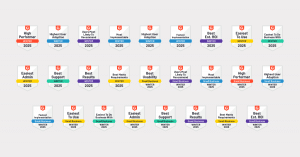Architecture practices thrive on connection. Every project depends on seamless communication between project managers and designers, accurate data flowing from timesheets to invoices, and real-time collaboration across teams and clients. Yet many firms still operate with disconnected tools: spreadsheets here, standalone accounting software there, communication platforms somewhere else entirely.
When your technology stack works in isolation, your team does too. Hours disappear into manual data entry, information sits trapped in silos, and the real work of design and delivery gets pushed aside by administrative tasks. The most successful firms today are building integrated ecosystems where every tool communicates seamlessly, creating a single source of truth that powers smarter decisions and stronger project outcomes.
Why Integration Matters in Architecture
Architecture projects are inherently complex. Practices need to coordinate internal staff, external consultants, subcontractors, and clients while juggling scope changes, tracking billable hours, monitoring budgets, and maintaining compliance records. Without smart architecture project management software that integrates your systems, this complexity becomes chaos.
Consider the typical workflow in a disconnected system. Someone enters timesheets in one platform, then manually transfers that data to invoicing software. Project budgets live in spreadsheets that never update your financial dashboards. Client emails sit buried in inboxes, completely separated from the project files they reference. Every disconnection wastes time, increases errors, and blinds firms to how projects are actually performing.
According to the 2025 Architecture and Engineering Industry Benchmark Report, more than half of firms report that at least one in four projects goes over budget. The main culprits are scope creep, underquoting, and poor tracking.
Meanwhile, over a third identify client communication and approvals as their biggest time wasters. Without integrated systems, firms spend their time putting out fires instead of preventing them.
Connected systems eliminate double entry. Data flows automatically between platforms, giving project managers instant visibility into finances, resources, and progress. Your team spends less time on administrative work and more time doing what they do best: delivering exceptional projects.
Project Management & Workflow Integrations
Project management sits at the heart of every successful architecture practice. Integrated project management software creates the operational backbone that supports delivery from initial concept through final billing, ensuring that schedules, tasks, resources, and deliverables remain synchronised across the entire project lifecycle.
Task Coordination and Scheduling
Effective task management requires clear visibility into what needs to happen, who is responsible, and when deadlines approach. Integrated project management platforms connect task assignment with resource allocation, automatically updating team capacity when new responsibilities are assigned.
Gantt chart integrations provide visual timeline management that links directly to project budgets and resource plans. When a project manager adjusts timelines, the system automatically recalculates resource requirements and flags potential conflicts, preventing overbooking and scheduling gaps before they impact delivery.
Integration with time tracking systems creates powerful feedback loops. As team members log hours against specific tasks, project management software automatically updates completion percentages, compares actual progress against planned schedules, and alerts managers to variances. Real-time data enables proactive course correction rather than reactive crisis management.
Document Management and Collaboration
Architecture projects generate enormous volumes of documentation: drawings, specifications, calculations, correspondence, contracts, and compliance records. Managing these documents across disconnected systems creates version control chaos and compliance risks.
Integrating with SharePoint allows firms to centralise project files while still working with a familiar interface. Project files automatically organise according to defined structures, ensuring team members can locate current information without searching through email attachments or personal drives. Automatic revision tracking creates clear audit trails, recording when documents are updated, who made changes, and which versions were shared with clients or regulatory authorities.
Workflow Automation
Zapier integrations unlock nearly limitless workflow automation possibilities. Firms can create custom triggers that automatically initiate actions across different platforms. When a project reaches a specific milestone, the system can automatically generate invoices, send client notifications, update resource allocations, or create task lists for the next phase.
Automations eliminate repetitive administrative work that drains professional time. Instead of manually updating multiple systems when project status changes, staff simply update one platform and watch information propagate automatically. The cumulative time savings become significant across dozens or hundreds of projects annually.
Premium API access enables deeper customisation for firms with specific integration requirements. Whether connecting proprietary design software, specialised calculation tools, or industry-specific platforms, robust APIs ensure data flows seamlessly between Total Synergy and complementary systems.
Communication & Collaboration Integrations
Effective communication determines project success as much as technical expertise. Integrated communication platforms ensure information reaches the right people at the right time while maintaining comprehensive records for reference and accountability.
Messaging and Email
Microsoft Teams integration brings project communication into structured channels organised by project, client, or functional team. Instead of conversations scattered across personal inboxes, discussions happen in shared spaces where context remains visible and searchable. Team members joining projects mid-stream can review historical discussions to understand decisions and direction without requiring extensive briefings.
Email integrations like Mail Manager automatically file correspondence into project-specific folders within both Total Synergy and Outlook. Bidirectional filing ensures everyone accessing project information sees the complete picture, regardless of which system they primarily use. Search functionality spans both platforms, enabling instant retrieval of relevant communications years later whenever you need them.
Client Engagement
Customer relationship management (CRM) integrations through platforms like Salesforce, HubSpot, and SugarCRM connect business development activities with project delivery. When proposals convert to active projects, client information, scope details, and commercial terms automatically transfer into project management systems. Seamless handoffs prevent information loss during transitions and ensure delivery teams understand client expectations from day one.
CRM integrations also enable sophisticated tracking of client satisfaction and repeat business potential. As projects progress, client interactions, feedback, and change requests accumulate in centralised profiles, helping firms identify their best clients, understand what types of projects generate the strongest margins, and make strategic decisions about business development focus.
Accounting & Finance Integrations
Financial integration separates profitable practices from struggling ones. Architecture firms operate on complex fee structures, manage significant accounts receivable, and require precise tracking of project-level profitability. Disconnected financial systems make accurate tracking nearly impossible while creating compliance risks.
Invoicing, Payments, and Expenses
Xero, MYOB AccountRight Live, QuickBooks Online, Sage, and Wiise integrations enable seamless two-way exchange of financial data. When project teams complete billable work and generate invoices within project management software, financial data automatically syncs to accounting platforms, eliminating double entry while ensuring general ledgers remain current without additional bookkeeping effort.
The integration works both directions. When clients submit payments or firms incur expenses, accounting software updates automatically flow back to project financials. Project managers gain real-time visibility into outstanding receivables, payment timing, and actual costs against budget without running separate reports or requesting finance team updates.
Expense tracking integrations make it easy to categorise costs and link them to specific projects. Everything stays organised for accurate financial records and smooth reimbursement.
Payroll and Budgeting
HR platform integrations with systems like BambooHR, BrightHR, and People HR connect workforce management with project delivery, enabling seamless integration between these systems. Staff availability, leave schedules, and skills profiles sync automatically with resource allocation tools.
Project managers scheduling work can immediately see who is available, what qualifications they possess, and how assignments align with capacity without contacting HR or reviewing separate spreadsheets.
Payroll integrations connect approved timesheets directly to payment processing, so the hours your team tracks for billing automatically flow to payroll. No discrepancies, no confusion. Everyone gets paid accurately for the work they’ve done.
Financial Reporting
Power BI dashboard integrations transform raw financial data into actionable insights. Rather than waiting for month-end reports, leaders access real-time visibility into practice-wide financial performance, project profitability trends, work-in-progress balances, and debtor aging.
Dashboards aggregate data from project management, accounting, and operational systems to provide comprehensive views impossible with disconnected tools.
Financial reporting integrations enable sophisticated analysis that drives strategic decisions. Firms can quickly identify which project types generate the strongest margins, which clients pay most reliably, which service lines consume disproportionate resources, and where operational inefficiencies erode profitability. Armed with these insights, leadership teams make evidence-based decisions about market focus, service offerings, and operational improvements.
Unlock End-to-End Integration with Total Synergy
Total Synergy has spent over 25 years understanding the unique challenges of A&E practices, building a platform that unites budgeting, project management, time tracking, resource allocation, invoicing, and financial reporting with the external tools you already rely on.
Our integrations with leading accounting platforms, collaboration tools, and workflow automation systems mean you can finally stop wrestling with spreadsheets and start focusing on what you do best: designing exceptional projects and building lasting client relationships. The clearest path to project profitability doesn’t require abandoning your existing tools. It requires connecting them properly. Book a demo today and discover how Total Synergy can transform your practice’s efficiency and profitability.



